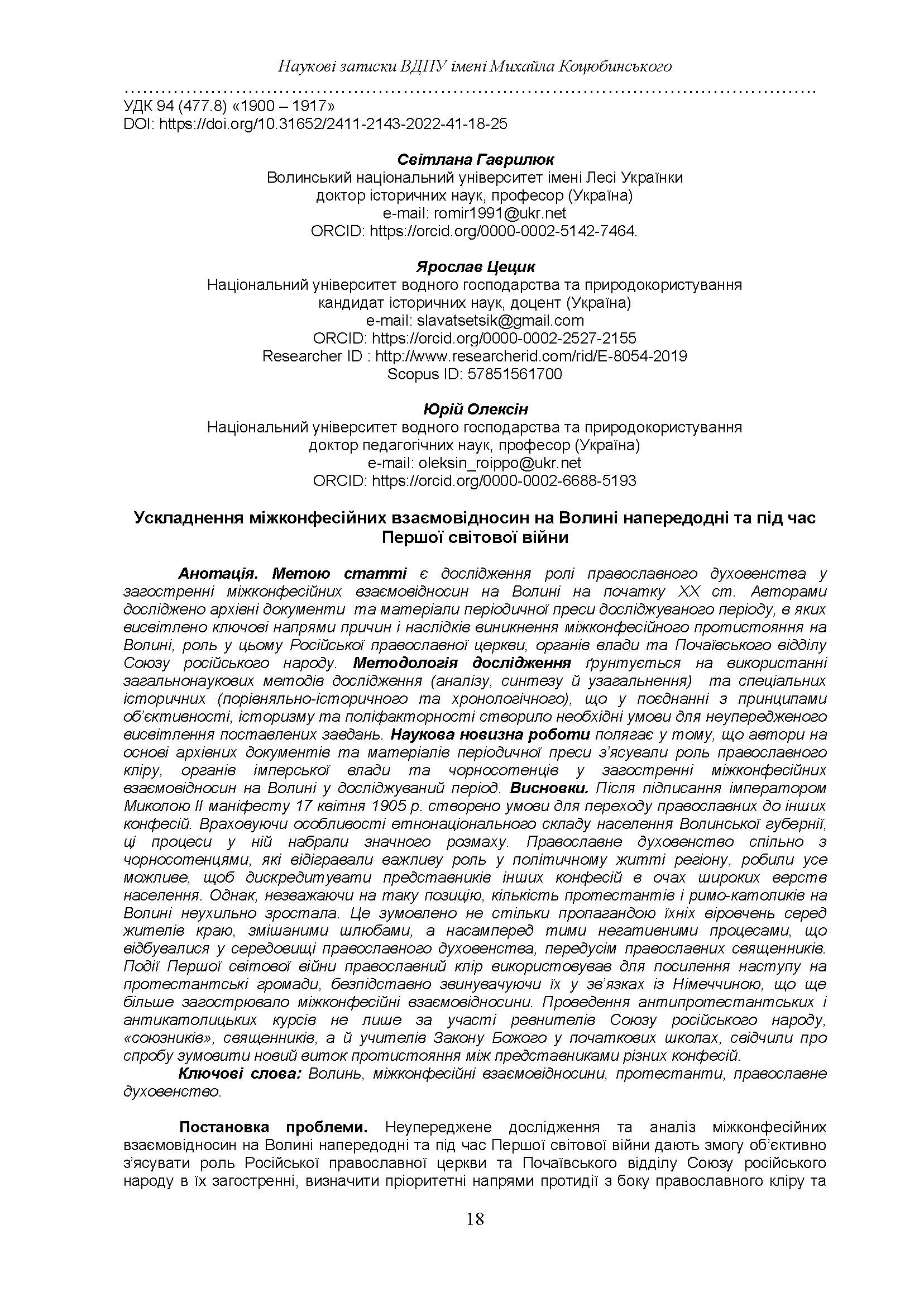Abstract
The purpose of the article is to study the role of the Orthodox clergy in the aggravation of inter-confessional relations in Volyn at the beginning of the 20th century. The authors have researched archival documents and periodical press materials of the researched period, which highlight the key directions of the causes and consequences of the inter-confessional confrontation in Volyn, the role of the Russian Orthodox Church, authorities and the Pochaiv branch of the Union of the Russian People in this. The research methodology is based on the use of general scientific research methods (analysis, synthesis and generalization) and special historical (comparative-historical and chronological) methods, which, in combination with the principles of objectivity, historicism and multifactoriality, created the necessary conditions for impartial coverage of the tasks. The scientific novelty of the work lies in the fact that the authors, on the basis of archival documents and materials from the periodical press, found out the role of the Orthodox clergy, the imperial authorities and the Black Hundreds in the aggravation of inter-religious relations in Volyn in the period under study. Conclusions. After Emperor Nicholas II signed the manifesto on April 17, 1905, conditions were created for the transition of Orthodox to other denominations. Taking into account the peculiarities of the ethno-national composition of the population of the Volyn province, these processes have gained significant momentum in it. The Orthodox clergy, together with the Black Hundreds, who played an important role in the political life of the region, did everything possible to discredit representatives of other faiths in the eyes of the general population. However, despite this position, the number of Protestants and Roman Catholics in Volyn steadily increased. This was caused not so much by the propaganda of their beliefs among the inhabitants of the region, by mixed marriages, but primarily by those negative processes that took place among the Orthodox clergy, primarily Orthodox priests. The events of the First World War were used by the Orthodox clergy to intensify their attacks on Protestant communities, unjustifiably accusing them of ties to Germany, which further aggravated inter-religious relations. Conducting anti-Protestant and anti-Catholic courses not only with the participation of zealots of the Union of the Russian People, «allies», priests, but also teachers of the Law of God in primary schools, testified to an attempt to create a new round of confrontation between representatives of different faiths
References
Абрамович, Н. (1906). Абрамович Н. Свобода совести. К годовщине манифеста. Волынская жизнь. 17 (30) октября. 1906. 3. 1.
А. (1916). А. П. С. Миссионерское совещание. Волынские епархиальные ведомости. Часть неофициальная. 10-го марта. 10–11. 119.
Боговский, И. (1916). Мировая война. Волынские епархиальные ведомости. Часть неофициальная. 28-го апреля. 18. 171–173.
Волосов, С. (1914). Землевладелец. Корреспонденции. Приходские и церковные порядки (письмо в редакцию). Наша Волынь. 10-го марта. 65. 3.
Всеподданнейший (1913). Всеподданнейший отчёт волынского губернатора. Наша Волынь. 11 декабря. 112. С. 2.
ДАЖО – Державний архів Житомирської області.
Дмитриенко, М. (1914). Архиепископ Антоний (К переводу в Харьковскою епархию). Наша Волынь. 23 мая. 133. 2.
Единство (1916). Единство и свобода в христовой церкви и извращение этих начал в латинистов и протестантов. Волынские епархиальные ведомости. Часть неофициальная. 24 марта. 13. 136–137.
Именной (1906). Именной Высочайший Указ. О порядке устройства отделившимися от православия сектантами общин, а также о правах и обязанностях оних лиц. Волынская жизнь. 24 октября (6 ноября). 9. 1.
Кленовин, В. (1916). Об отношении к ужасам войны. Волынские епархиальные ведомости. Часть неофициальная 7-го января. 2. 17–19.
Махаев, Н. (1916). О необходимости религиозного воспитания. Волынские епархиальные ведомости. Часть неофициальная. 18-го февраля. 8. 87–92.
Н. (1916). Н. В. Штунда, немецкие колонисты и Малороссия. Волынские епархиальные ведомости. Часть неофициальная. 13 августа. 33. 509–511.
Недельский, С. (1916). Секта «Корниевцев». Волынские епархиальные ведомости. Часть неофициальная. 1-го декабря. 48–49. 359–362.
Опря, І. (2012). Національний склад протестантських громад Правобережної України на початку ХХ ст. Наукові праці Кам’янець-Подільського державного університету. 12. 162–168.
Хитровська, Ю. В. (2018). Громадська думка щодо становища РПЦ та вплив православного духовенства на населення Правобережної України наприкінці ХІХ – на початку ХХ ст. (Крізь призму публікацій православної преси). Сторінки історії. 45. 19–28. https://doi.org/10.20535/2307-5244.45.2017.117189
Циркуляр (1916). Циркуляр о сектантах. Волынские епархиальные ведомости. Часть официальная. 22-го сентября. 36. 3.

This work is licensed under a Creative Commons Attribution 4.0 International License.
Copyright (c) 2022 Світлана Гаврилюк, Ярослав Цецик, Юрій Олексін





